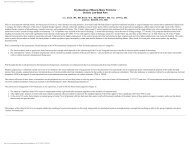Atlas of the muscle motor points for the lower limb: implications for ...
Atlas of the muscle motor points for the lower limb: implications for ...
Atlas of the muscle motor points for the lower limb: implications for ...
You also want an ePaper? Increase the reach of your titles
YUMPU automatically turns print PDFs into web optimized ePapers that Google loves.
Eur J Appl Physiol (2011) 111:2461–2471 2463<br />
Table 1 Muscles, anatomical landmarks, and thickness <strong>of</strong> <strong>the</strong> subcutaneous layer are reported<br />
Muscle Proximal–distal anatomical landmarks <strong>of</strong> <strong>the</strong> reference line Average (±SD)<br />
values <strong>of</strong><br />
subcutaneous layer<br />
thickness (mm)<br />
Vastus lateralis: proximal <strong>motor</strong><br />
point<br />
Vastus lateralis: central <strong>motor</strong><br />
point<br />
Vastus lateralis: distal <strong>motor</strong><br />
point<br />
Rectus femoris: proximal <strong>motor</strong><br />
point<br />
Rectus femoris: distal <strong>motor</strong><br />
point<br />
Vastus medialis: proximal<br />
<strong>motor</strong> point<br />
Vastus medialis: distal <strong>motor</strong><br />
point<br />
Anterior superior iliac spine–superolateral border <strong>of</strong> <strong>the</strong> patella 10 ± 5<br />
Apex <strong>of</strong> greater trochanter–superolateral border <strong>of</strong> <strong>the</strong> patella 7 ± 3<br />
Apex <strong>of</strong> greater trochanter–superolateral border <strong>of</strong> <strong>the</strong> patella 7 ± 3<br />
Anterior superior iliac spine–superior border <strong>of</strong> <strong>the</strong> patella 10 ± 5<br />
Anterior superior iliac spine–superior border <strong>of</strong> <strong>the</strong> patella 10 ± 4<br />
Anterior superior iliac spine–superomedial border <strong>of</strong> <strong>the</strong> patella 8 ± 3<br />
Anterior superior iliac spine–joint space in front <strong>of</strong> <strong>the</strong> anterior border <strong>of</strong> <strong>the</strong> medial<br />
collateral ligament<br />
Biceps femoris: long head Ischial tuberosity–apex <strong>of</strong> <strong>the</strong> fibular head 12 ± 4<br />
Biceps femoris: short head Ischial tuberosity–apex <strong>of</strong> <strong>the</strong> fibular head 9 ± 4<br />
Semitendinosus Ischial tuberosity–medial epicondyle <strong>of</strong> <strong>the</strong> tibia 10 ± 4<br />
Semimembranosus Ischial tuberosity–medial epicondyle <strong>of</strong> <strong>the</strong> tibia 7 ± 3<br />
Tibialis anterior: proximal Apex <strong>of</strong> <strong>the</strong> fibular head–apex <strong>of</strong> <strong>the</strong> medial malleolus 5 ± 2<br />
<strong>motor</strong> point<br />
Tibialis anterior: distal <strong>motor</strong> Apex <strong>of</strong> <strong>the</strong> fibular head–apex <strong>of</strong> <strong>the</strong> medial malleolus 4 ± 2<br />
point<br />
Peroneus longus Apex <strong>of</strong> <strong>the</strong> fibular head–apex <strong>of</strong> <strong>the</strong> lateral malleolus 5 ± 2<br />
Medial gastrocnemius Medial knee joint line–posterior superior portion <strong>of</strong> <strong>the</strong> calcaneal tuberosity 7 ± 2<br />
Lateral gastrocnemius Apex <strong>of</strong> <strong>the</strong> fibular head–posterior superior portion <strong>of</strong> <strong>the</strong> calcaneal tuberosity 6 ± 2<br />
6 ± 3<br />
position was temporarily marked with ink and subsequently<br />
measured with respect to <strong>the</strong> reference line. The position <strong>of</strong><br />
<strong>the</strong> reference electrode was <strong>the</strong> following: (a) just above<br />
<strong>the</strong> popliteal cavity/patella <strong>for</strong> <strong>the</strong> investigation <strong>of</strong> <strong>the</strong><br />
quadriceps/hamstring <strong>muscle</strong>s, respectively; (b) just below<br />
<strong>the</strong> tibial tuberosity/popliteal cavity <strong>for</strong> <strong>the</strong> investigation <strong>of</strong><br />
<strong>the</strong> gastrocnemii/tibialis anterior and peroneus longus<br />
<strong>muscle</strong>s, respectively. For all <strong>muscle</strong>s and subjects,<br />
0.15 ms square pulses were delivered through <strong>the</strong> pen<br />
electrode at a frequency <strong>of</strong> 2 Hz: <strong>the</strong> minimum current<br />
amplitude required to produce a visible contraction was<br />
\10 mA. Electrical stimulation was provided by a constant-current<br />
stimulator (DS7A, Digitimer Ltd, Welwyn<br />
Garden City, England).<br />
Since <strong>the</strong> thickness <strong>of</strong> <strong>the</strong> subcutaneous layer significantly<br />
affects <strong>the</strong> effectiveness <strong>of</strong> <strong>the</strong> stimulation (and<br />
<strong>the</strong>re<strong>for</strong>e <strong>the</strong> detectability <strong>of</strong> <strong>the</strong> <strong>muscle</strong> <strong>motor</strong> <strong>points</strong>), it<br />
was measured by ultrasonography (FFSonic UF-4000L,<br />
7.5 MHz linear array transducer, Fukuda Denshi, Tokyo,<br />
Japan), at <strong>the</strong> position <strong>of</strong> <strong>the</strong> identified <strong>motor</strong> <strong>points</strong>, as <strong>the</strong><br />
perpendicular distance between <strong>the</strong> bottom <strong>of</strong> <strong>the</strong> skin and<br />
<strong>the</strong> superior <strong>muscle</strong> fascial layers, thus <strong>the</strong> superficial<br />
aponeurosis was not included (Nordander et al. 2003). A<br />
water-soluble transmission gel was placed over <strong>the</strong> head <strong>of</strong><br />
<strong>the</strong> probe to increase acoustic coupling. Care was taken to<br />
exert minimal pressure to avoid compression <strong>of</strong> <strong>the</strong><br />
underlying tissues. For <strong>the</strong> different <strong>muscle</strong>s, <strong>the</strong> mean<br />
values <strong>of</strong> <strong>the</strong> subcutaneous layer thickness (Table 1) were<br />
comparable to previously reported data <strong>for</strong> normal weight<br />
subjects (Davies et al. 1986; Jones et al. 1986; Wallner<br />
et al. 2004).<br />
Statistical analysis<br />
Motor point positions along <strong>the</strong> reference lines are reported<br />
in both absolute (mean ± SD) and percentage values in<br />
relation to <strong>the</strong> total length <strong>of</strong> <strong>the</strong> reference line, starting<br />
from <strong>the</strong> proximal or distal anatomical landmark (that<br />
corresponded to a landmark <strong>of</strong> <strong>the</strong> knee joint <strong>for</strong> most <strong>of</strong><br />
<strong>the</strong> investigated <strong>muscle</strong>s).<br />
The uni<strong>for</strong>mity (across all subjects) <strong>of</strong> <strong>the</strong> <strong>motor</strong> point<br />
position along <strong>the</strong> reference line was estimated <strong>for</strong> each<br />
<strong>muscle</strong> on <strong>the</strong> basis <strong>of</strong> <strong>the</strong> spread (standard deviation, SD)<br />
<strong>of</strong> <strong>the</strong> normalized <strong>motor</strong> point position: normalization was<br />
123






